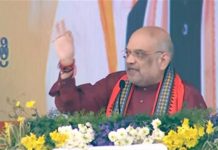 The interim budget of the outgoing NDA government has belied the expectations of the rural voters. Revised policy framework to tackle low prices of food produce and stagnant farmers’ income along with a holistic approach to pull out the farmers from economic distress was expected and predicted in media reports during the last few weeks.
The interim budget of the outgoing NDA government has belied the expectations of the rural voters. Revised policy framework to tackle low prices of food produce and stagnant farmers’ income along with a holistic approach to pull out the farmers from economic distress was expected and predicted in media reports during the last few weeks.
The budget proposals announced by the Finance Minister Piyush Goyal convey a lack of intent on part of Modi led NDA government to seriously address the issues of farmers in India. The farmers across India want a free market and a remunerative price of their produce and considered the budget proposals only as empty announcements of new schemes or dressing up of old schemes, without much change on the ground.
According to Dharmendra Malik of Bhartiya Kisan Union, Government’s declaration of PM Kisan Samman Nidhi is effectively an insult to the farmers — 6000 per family per year too meager to make any difference to the farmers’ plight.
Finance Minister said that it is a major step towards doubling farmers’ income and that the farmers will not need to go to moneylenders. This shows that the government is completely disconnected from the reality of farmers. The Cost of Cultivation for most crops is around 20,000 to 25,000 per acre. A 5-acre farmer needs more than 1,00,000 as an investment for each season. How can 6000 per year given in three installments remove his/her need to go to moneylender?
Comparing the new proposed scheme of Government of India with some states’ existing similar schemes, he said that Rythu Bandhu scheme of Telangana provides 10,000 per acre of support, which means that a 5-acre farmer would get 50,000 per year, giving at least partial support towards cultivation cost.
KALIA scheme of Odisha government provides 10,000 per farmer in two installments. The support covers Landless agricultural workers, Tenant farmers and Sharecroppers also, whereas all these categories are left out of PM-KISAN. Both Rythu Bandhu and KALIA include a life insurance component of 5 lakhs and 2 lakhs respectively. Therefore, the PM-KISAN scheme is disadvantageous compared to the two schemes already in place in Telangana and Odisha.
The farmers are annoyed for the Millions of tenant farmers, sharecroppers, landless agricultural workers, adivasi farmers without land pattas, distressed rainfed farmers owning more than 5 acres have been excluded in this scheme.
Gunvant Patil, a senior farmer leader from Maharashtra told that the schemes like PM Samman Nidhi makes a farmer feel like a beggar. Like any other business, agriculture cannot sustain on support by government for long. Government is always keen to intervene if food prices rise but farmers are left to fend for themselves when prices drop. The Minimum support price regime is also eyewash. Such initiatives only result in burgeoning fiscal budgets of the governments and farmers get a minimal benefit out of such schemes.
The farmers are also skeptical of how the funds will reach 12 crore eligible farmers within a month or two. It is almost impossible to prepare a master list of all the eligible landholders based on land records across the country.
There is speculation that some existing database such as crop insurance database or soil health database would be used. However, this would be highly problematic because lakhs of farmers may not have opted to include in those schemes for various reasons including not being convinced of their utility. If they are left out of the PM-KISAN for that reason, it would be a large injustice.
Hiking MSP and ensuring that all farmers get the Minimum Support Price were the major declarations of the previous Budget 2018. The raising of MSP to 1.5 times Cost of Production deceived farmers as the government used a partial cost measure (A2+FL) instead of Comprehensive Cost of Production (C2) while calculating MSP.
The Government announced the PM-AASHA scheme with major fanfare, promising to ensure that all farmers will be able to sell their crop at or above MSP. This is a combination of expanded procurement under Price Support Scheme, Price Deficiency Payment System on the lines of Bhavantar Bhugtan Yojana of Madhya Pradesh, and Private Stockist and procurement scheme. However, the total Budget allocation for PM-AASHA is only 1500 crores in this budget. In order to fulfill the mandate of PM-AASHA, a minimum of 50,000 crores to 1 lakh crore was required, told the farmers.
The success of the implementation of the proposed scheme can be evaluated from the fact that the expenditure of Madhya Pradesh government on Bhavantar yojana for just 5 crops was 1800 crores in 2017-18, that too when they reached only around 20 per cent of the farmers who cultivated those crops. It was calculated that if the scheme covered all farmers who cultivated those crops, the requirement would have been 8400 crores (Dr.Ashok Gulati and Siraj Hussain).Hence, the government has effectively given up on ensuring MSP reaches farmers. The reality is that in most crops, the farmers got much below MSP in Kharif 2018-19.
Framers assume that the Interest Subvention announcement is of minor significance because it applies only to loans which are rescheduled during calamities. With most natural calamities not even being declared by the government and poor implementation of loan rescheduling, this benefit would hardly go to 1 per cent of the farmers.
While farmers in several states are already getting interest-free crop loans, there was expectation that Union government will expand interest-free crop loans across India, but it proved to be a disappointment. The government was completely silent on the demand for loan waiver and debt relief mechanisms for the crores of indebted and distressed farmers.
Prime Minister Modi endorsed in one of his interviews in January, 2019, “There is only a very small segment of farmers who take loans from banks while a majority of them take loans from moneylenders.”
Contrary to the expectations, the government has not announced any steps to make sure that the majority of farmers start getting bank loans. The Finance Minister in Budget 2018 speech assured that tenant farmers and sharecroppers would be identified and extended crop loans and institutional credit. No progress on that, and no reference in this year’s Budget speech or any allocation in the Budget has been made.
The government declared that the government “will do anything for protection and promotion of the cow”, and set up the National Kamadhenu Ayog — a Commission to ensure the welfare of the cow, but there is no statutory Farmers’ Commission for the welfare of farmers who nurture the cows. He did not even acknowledge the huge problem of stray cattle that have become the scourge of the farmers in villages across India, due to the irrational policies on cattle trade and the havoc by ‘gaurakshaks’.
Meanwhile, the government’s support to dairy farming and animal husbandry has been scanty. In Budget 2017-18, with a lot of applause, a Dairy Infrastructure Development Fund was announced with 10,881 crores allocation, to support and finance dairy units across the country within three years. Two years have completed, and only 440 crores has been disbursed so far, assert farmers. Similarly, in Budget 2018-19, an Animal Husbandry Development Fund of 2430 crores was announced but it has not yet been set up after a whole year.
Though an Output Framework was announced two years ago, no Outcome Budget has been presented based on the output framework. It may be for good reason, because the performance is poor in many respects — as seen above in Price Support, Dairy and Animal Husbandry, and below in several schemes. In the Pradhan Mantri Fasal Bima Yojana, the target output was coverage of 50 per cent of farm holdings but the actual coverage fell from 29 per cent in 2016-17 to 24 per cent in 2017-18 and this has further decreased in 2018-19.
Converting 22,000 rural haats into fully equipped agricultural markets (GrAM) was declared as a priority in Budget 2018-19. But so far only 85 are complete and 180 are in progress. In NREGS, 61,000 crores was spent last year, but the demand from states was more than 80,000 crores. The pending payments itself runs to more than 16,000 crores. But the allocation is lowered to 60,000 crores this year (compared to Revised Budget 2018-19).
The Interim Union Budget has plethora of announcements on farming sector, apparently to woo the voters engaged in farming but the report card of last four and a half years and the tight fiscal road-map for the government leaves many questions unanswered.
letters@tehelka.com













